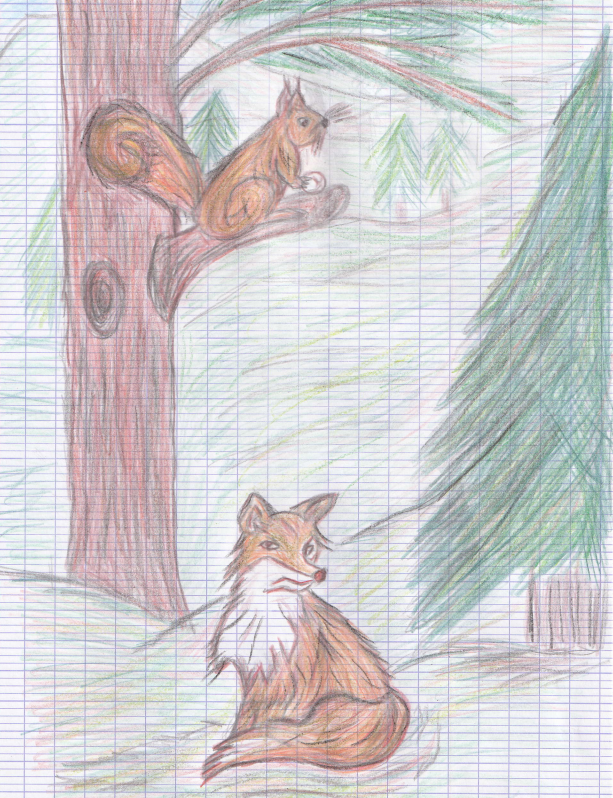C5 WORKSHOP W6
 Climates, environments and fauna
Climates, environments and fauna
Des dessins produits et commentés par les élèves de Seconde OIB (Géographie avec M Vanderplancke) le 18 décembre.
Les élèves étudient les milieux naturels, leur valorisation et leur protection, en prenant l'exemple français. Dans ce cadre ils ont appris à construire et commenter des graphiques illustrant le climat. On leur demande, en tant que participants à la semaine de mobilisation européenne dite ERASMUS MOB, de produire par ailleurs quelques dessins librement inspirés montrant l'environnement et sa faune caractéristique. Ce travail sera présenté et commenté en ligne au cours de la visioconférence implantée le 18 décembre à 10 h 30.
DAY 5 / Friday December 18 (one hour and a half) The final workshop (W6) led by the class of Seconde 6, hard core of the local target group, saw the students of the Lycée Ravel present the climate and the fauna of the French regions and the partners report on the natural environments that exist in their own region, the entire virtual group discussing existing protection measures or that should be taken according to them.
See other ERASMUSMOB contents clicking on the REPORT tab
|
BASQUE COUNTRY EUSKAL HERRIA - Le Pays Basque
Fox and Squirrel Azeria eta Urtxintxa - Le renard et l'écureuil |
 |
OTHER CONTENTS FURTHER
OMBROTHERMIC DIAGRAMS. Click on the sea below to access to a tutorial (in order to learn how to make graphics of your local climates):
W6 : family pic
 Quelques diapositives pour lancer le débat
Quelques diapositives pour lancer le débat
A SLIDE PRESENTATION
Typical animals in climate areas from France
DEERS AND FOXES : CAMBRAI CLIMATE
Cambrai's climate is oceanic, and a bit cold. But it remains a mild climate, characterized by rainy weather. In summer the temperature does not exceed 20 ° C on average, but in winter it remains above zero degrees. Cambrai is located in the "Nord department" in the region called "Hauts de France" (next to Belgium, far of St Jean de Luz, since almost 1000km away). Its climate is that of the Paris Basin (Normandy, Picardy, Champagne, Île de France, etc).
The animals we have drawn are the deer and the fox. With the wild boar and others they are numerous in this part of the country rich in royal forests formerly frequented by the kings, who liked to practice hunting there. These royal forests have been preserved, even very near Paris, until today. To protect them, should hunting be prohibited or is it enough, in your opinion, to put fences between the roads and the woods?
SEALS, BEAVERS AND SEAGULLS : BREST CLIMATE
We are going to present you the oceanic climate of Brest, a city located in Brittany. Britanny is in Northwestern France. All year, the temperature is cool but sometimes a little cold, with a humide, windy and rainy weather. In winter the climate is less cold than elsewhere in Northern France because of warm oceanic currents and also because the wind often blows from the south. Brest is a coastal city with very beautiful cliffs and many lighthouses because there is a lot of maritime trafic in the Channel between France and Great Britain.
We chose to draw a seal because they are present all along the west coast of France. Black tides are dangerous for seals. Could we do something to help them? We also selected a beaver, because it's an unusual animal but a very beautiful one in our opinion. This animal builds some houses with wood and it's a problem since more and more trees are being cut, letting them become homeless. How could we help beavers in order to avoid them disappearing? Where do beavers still live in Europe ? We showed a seagull because there's a lot in our area and in all the south western coast in France. It was funny for us to find this animal in the northern part of France. Do you have some seagulls in your city?
COLD-BLOODED ANIMALS : MARSEILLE CLIMATE
Marseille is next to the Mediteranean Sea and has a subtropical climate wich seems us to be very contrasted In winter the weather is mild, while in summer it's very hot and dry ! In winter the temperatures drop to 6°C while it rises on average to 23°C in summer. So the temperature range between summer and winter is 17°C. It's a lot! Only the three summer months are dry. The rest of the year it rains "normally" - we mean: all the time, as it is the case anywhere in France! French mediterranean territories are located in Corsica island and on the so called "French riviera". The french mediterranean coast is not so far from the Basque Country since there are only 400 kilometers between Saint Jean de luz and Perpignan, a city located in Catalonia, on the other side of the Pyrenees mountains. But we are even closer to Spanish mediterranean areas (only 100 kilometers to Pamplona).
The Mediterranean landscape seems quite dry that's why the vegetation is not always green except for a few trees and shrubs typical of the region (maquis, umbrella pines) wich do not need a lot of water, and the sea's colour is light and turquoise. There is a very diverse flora and fauna that live on the sea shore or in the hinterland. It is also a refuge for cold-blooded animals because they absolutely need a hot climate: we find here some reptiles and turtles (on our drawing, too). But also some jelly fishes, sea urchins, sharks and other subtropical terrestrial or marine animals. Can you imagine how to protect these animals although the mediterranean countries are so attractive for inhabitants, tourism and other economic activities ?
THE DRAWINGS AND CONVERSATION WORKSHOP: VIDEO REPORT
Click on the horses to find all the ERASMUS MOB contents
 Ombrothermic chart of Bayonne
Ombrothermic chart of Bayonne
